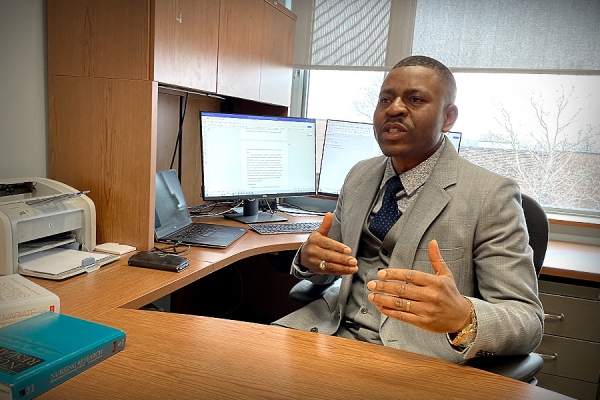 Eric Tanlaka's research on the role of nurses in stroke rehabilitation seeks to enhance job fulfillment while bringing about changes to Ontario’s nursing curriculum.
Eric Tanlaka's research on the role of nurses in stroke rehabilitation seeks to enhance job fulfillment while bringing about changes to Ontario’s nursing curriculum.
During Black History Month, the Faculty of Nursing is featuring pioneers and difference-makers in the profession, past and present. A series published on its website shares their stories of determination, resilience, and humanity.
Nursing professor Eric Tanlaka is part of a research team examining the role of nurses in stroke rehabilitation with the goal of improving job equity and augmenting Ontario’s nursing curriculum.
Funded by the Registered Practical Nurses Association of Ontario, the multi-phase research project reveals that hospital nurses performing functions in stroke rehabilitation units are not factored into the measurement of stroke rehabilitation outcomes — measurable results or effects that are assessed to determine the impact of a particular treatment or health-care action.
According to the study, while patients are in rehabilitation, physiotherapists, occupational therapists, and speech-language pathologists are key members whose services are measured in such outcomes. However, nurses also play a critical role, spending the most time with patients and providing comprehensive care throughout their recovery process.
“Nurses are pivotal members of interprofessional stroke rehabilitation teams,” says Dr. Tanlaka. “Yet their role is not clearly defined, and their contributions are not documented and recognized.”
Tanlaka says that nurses exhibit wide-ranging expertise and hands-on involvement within stroke rehabilitation units. While some nurses have expressed a need for further education and training in this field, others have highlighted their proficiency and experience, but perceive themselves as unequal contributors to the stroke patient’s rehabilitation program.
Increased job equity would also generate opportunities for leadership and management roles, allowing for a more diverse career path and greater job fulfillment.
Tanlaka’s goal is to lay a foundation for developing competencies for stroke rehabilitation and have them incorporated into Ontario’s university-level nursing curriculum.
“By standardizing education in this field of nursing, we can empower future nurses with knowledge, skills, abilities, and confidence when they enter the workforce,” says Tanlaka. “In the end, patient care is enhanced while nurses providing that care feel more valued, respected, and connected to their stroke rehabilitation units.”
More information can be found in Tanlaka’s article, “The Role and Contributions of Nurses in Stroke Rehabilitation Units: An Integrative Review”.
